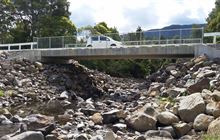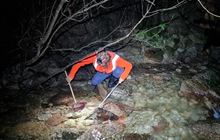Freshwater fish migration
Introduction
Many of New Zealand’s native freshwater fish species need to move up and downstream and to the sea and back during their lifecycles. It’s important that structures built into streams allow them to move freely.New Zealand’s freshwater fish use different habitats at different times in their lifecycle. Migratory species move between freshwater and the sea during their lifecycle.
For example, the whitebait species (īnanga, kōaro and kōkopu), lay their eggs in freshwater, move downstream to the sea as larvae, grow into juvenile fish at sea, then travel back upstream where they grow into adults. It’s essential that they can move within waterways to reach these habitats and complete their lifecycle.
Structures in streams can create barriers to fish movement and migration. If native fish cannot migrate and reach the habitats they need, their numbers can be reduced, or they may be lost from a stream completely. Some species of fish are more affected by barriers to migration than others. Inanga are weak swimmers and cannot climb, but kōaro and young eels can easily climb even vertical wet surfaces.
New Zealand has more than 50 native freshwater fish species but about 70% are Threatened or At Risk. New Zealand also has several sports fish, like trout and salmon, which also need to be able to migrate up and downstream.
To ensure healthy fish populations, a stream should:
- provide safe, easy up and downstream movement for all species and their various life stages
- have different water conditions (like areas of fast and slow flow) and natural hiding places for fish
- enable natural processes to continue, like sediment and debris moving downstream.
Barriers to fish migration
Any structure can be a barrier to fish migration if it is not installed correctly. Large drops and structures that are the wrong shape or undercut can stop fish migrating. Water that is too shallow or flowing too fast, can also affect fish movement.
Structures like overhanging or perched culverts stop most native fish migrating. The length of the culvert and the conditions inside, like fast-flowing water, can also prevent or reduce fish movement up and downstream.
Dams, weirs or other structures that block waterways also prevent fish passage. Fish can be sucked into water intakes if a suitable fish screen has not been installed.
Flood and tide gates can be barriers to fish migration. Closed gates block fish movement and the fast, turbulent water moving downstream when the gates are open, often stops fish moving through. These structures also change the habitat upstream by creating temporary or permanent artificial lakes.
Barriers to protect native fish
Although many of our native fish need to move within streams, some species spend all their lives in streams and rivers and don’t need to migrate to the sea and back. These include our non-migratory galaxiids and mudfish many of which are threatened.
Natural barriers like waterfalls protect some habitats and populations of these native fish, but artificial barriers can also be built to keep invasive fish out.


